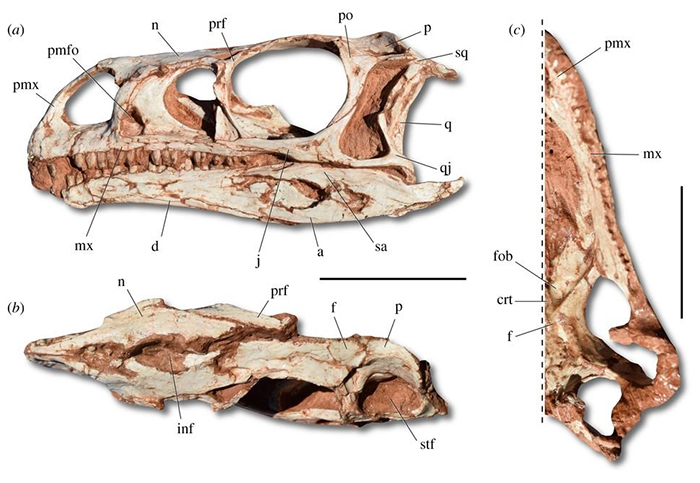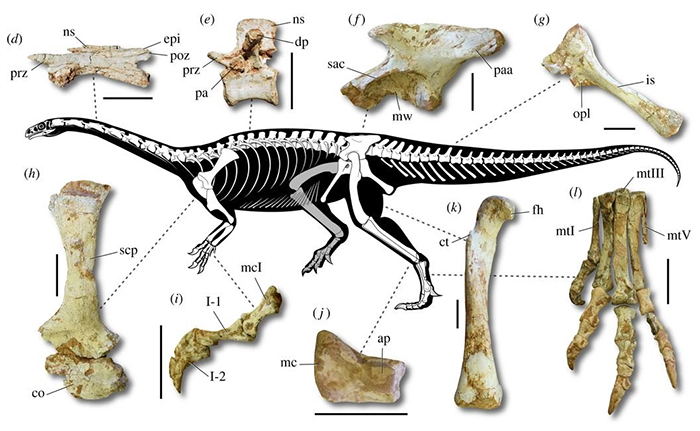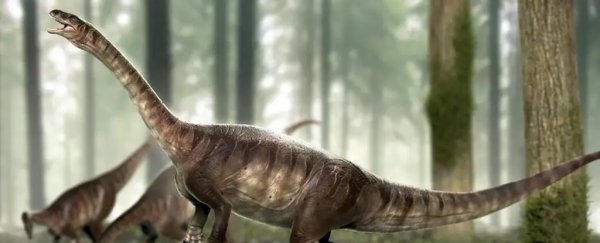Before the dinosaurs we're mostly familiar with, there was a group of smaller ancestors that we know very little about.
But now archaeologists have discovered three new well-preserved skeletons in Brazil, and it's teaching us more about this particular branch of the dino family tree.
The skeletons fit into a new dinosaur species that's been called Macrocollum itaquii, and you wouldn't have had to flee in the opposite direction if you saw one coming in real life – these animals were vegetarian, stood around 1.5 metres (5 feet tall), and weighed around 90 kilograms (200 pounds).
One of the key features of Macrocollum itaquii is its long neck – indeed it's the oldest long-necked sauropodomorph that has ever been dug up. That long neck would've helped these dinosaur ancestors compete for food sources and thrive, the team behind the discovery says.
 (Biology Letters)
(Biology Letters)
These dinosaurs roamed Earth around 225 million years ago, during the Triassic period: we're talking about when Brazil was still a part of the Pangaea supercontinent – to find skeletons this old that are this well preserved is hugely exciting for palaeontologists.
"There are three articulated skeletons in five tons of rock," one of the team, biologist Rodrigo Müller from the Federal University of Santa Maria in Brazil, told the Independent. "This is unique."
"It suggests these animals probably died together, as they share the same degree of disarticulation. So if they died together, these dinosaurs probably lived together."
The researchers think the find could teach us a lot about sauropods and the dinosaurs that came before them – specifically, how sauropods like the Brontosaurus and Diplodocus eventually got to be so big, up to ten times as long as Macrocollum itaquii from head to tail.
As they grew in size, sauropods switched to walking on four legs rather than two, to support all that additional size and weight.
 (Biology Letters)
(Biology Letters)
This period of dinosaur evolution is a key topic of interest for palaeontologists. The identification of Chilesaurus over the last few years has helped fill in some of the blanks in the dino family tree, but we've still got a lot of questions to answer. The new find is from much earlier in history.
As LiveScience reports, the find was prompted by a phone call from Müller's mother, telling him about fossils discovered by his uncle on a rural property in Agudo, southern Brazil.
Some six years and a lot of excavation later, we have the finished findings – so you never know what historical treasure lies buried in your back garden.
Palaeontologist Stephen Poropat from the Swinburne University of Technology in Australia, who wasn't involved in the new study, suggests the dinosaurs these fossils belong to might not have necessarily lived and died together.
It's also possible that the skeletons are grouped together because the spot was a watering hole or a swamp that trapped dinosaurs, Poropat told LiveScience.
Whatever the social habits of Macrocollum itaquii, it's a fascinating find that provides an invaluable piece of the fossil record jigsaw. Many future dinosaur studies will benefit from the information we can glean from these skeletons.
"This gives us an amazing picture of how these animals lived, which has never been done before," Müller told the Independent.
The research has been published in Biology Letters.
